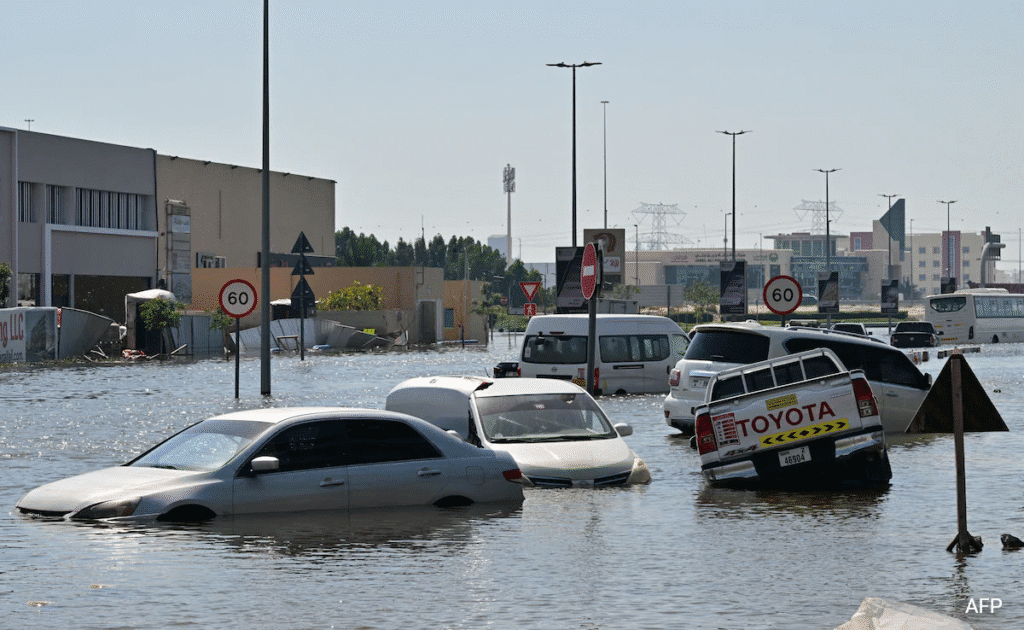2024 UAE Floods struck the country in April 2024, marking the most severe flooding in over seven decades. Triggered by unprecedented rainfall, the deluge began on April 15 and intensified on April 16, causing widespread destruction across Dubai, Sharjah, Abu Dhabi, and Ras Al Khaimah. The floods not only disrupted daily life but also damaged homes, roads, schools, and businesses, leaving thousands of residents temporarily displaced. Emergency services worked around the clock to rescue stranded individuals, provide medical care, and restore essential services. The event highlighted the vulnerability of urban areas to extreme weather and underscored the importance of advanced planning, resilient infrastructure, and effective government coordination in mitigating such disasters.
Unprecedented Rainfall: A Record-Breaking Event
The UAE’s National Center of Meteorology reported that between April 14 and 17, 2024, the country received up to 259 mm (10.2 inches) of rain—the heaviest in 75 years. Al Ain, a city near the Oman border, recorded a staggering 254.8 mm (10.03 inches) in less than 24 hours. This amount far exceeded the annual average rainfall for the region, which typically ranges between 30 to 50 mm. Experts noted that such extreme rainfall is highly unusual for the UAE’s arid climate, highlighting the growing risks of climate variability. Meteorologists emphasized that this event is a wake-up call for improved urban drainage, flood management, and emergency preparedness to mitigate future disasters. Authorities also pointed out that the combination of intense rainfall and existing infrastructure limitations contributed to rapid water accumulation, intensifying the impact on communities and transportation networks.
Widespread Damage Across the Emirates
The intense rainfall led to flash floods that inundated streets, homes, and critical infrastructure. In Dubai, vehicles were submerged, and roads became impassable. The city’s international airport experienced significant disruptions, with over 1,500 flights delayed or canceled over three days .

Sharjah and Ras Al Khaimah also reported severe flooding, with residential areas and businesses affected. The heavy rains caused landslides in hilly regions, further complicating rescue and relief efforts.
Human Impact and Casualties
The floods resulted in at least four fatalities in the UAE. Additionally, numerous individuals were injured, and thousands were displaced from their homes. The extreme weather conditions posed significant challenges to emergency services and healthcare facilities, which were overwhelmed by the scale of the disaster.

Economic Losses and Insurance Implications
The economic impact of the 2024 UAE floods was substantial, with estimated damages ranging between $2.9 billion and $3.4 billion. Insured property losses alone were projected to reach between $1.8 billion and $2.3 billion . The event highlighted vulnerabilities in the country’s infrastructure, particularly concerning drainage systems and flood preparedness.

Government Response and Recovery Efforts
In the aftermath of the floods, the UAE government allocated 2 billion dirhams (approximately $544 million) to repair homes and infrastructure damaged by the rains. Prime Minister Sheikh Mohammed bin Rashid al-Maktoum emphasized the importance of learning from the disaster to enhance future resilience, urging all federal and local authorities to prioritize rapid response and long-term planning. Relief efforts were coordinated across multiple government agencies, including the National Emergency Crisis and Disaster Management Authority (NCEMA), which worked tirelessly to provide emergency shelter, medical assistance, and essential supplies to affected communities.
Dubai announced a comprehensive $8.2 billion project named “Tasreef” to improve its rainwater drainage system. The initiative aims to increase the drainage capacity by 700%, ensuring better management of stormwater and reducing the risk of future flooding. The project includes upgrading existing drainage channels, constructing new retention basins, and deploying smart monitoring systems that can detect rising water levels in real time. Authorities also plan to collaborate with environmental experts and urban planners to integrate sustainable practices, such as green roofs and permeable pavements, into the city’s infrastructure. These efforts reflect the UAE government’s commitment to not only restoring normalcy but also building a resilient and future-ready urban environment capable of withstanding extreme weather events.
Climate Change and Future Preparedness
Experts have linked the extreme rainfall to climate change, which is expected to increase the frequency and intensity of such events in the region. While the UAE has not conducted cloud seeding during this particular storm, the event underscores the need for enhanced climate resilience strategies.
The 2024 floods serve as a wake-up call for the UAE to invest in sustainable infrastructure, improve urban planning, and implement comprehensive disaster preparedness programs to mitigate the impacts of future extreme weather events.
Conclusion
The 2024 UAE floods were a stark reminder of the vulnerabilities even in arid regions to extreme weather events. The unprecedented rainfall caused significant damage, loss of life, and economic setbacks. However, the swift government response and long-term infrastructure projects like “Tasreef” demonstrate a commitment to rebuilding and enhancing resilience against future disasters. As climate change continues to pose challenges, the UAE’s proactive measures will be crucial in safeguarding its citizens and infrastructure.
Do follow UAE Stories on Instagram














